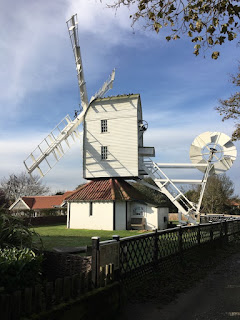Friday, January 10, 2020
Thorpeness, Suffolk
Moving building
For as long as I can remember, I’ve admired the combination of ingenuity and functionalism represented by the typical English post mill. The main body of the mill is designed as a lightweight wooden structure so that it can turn to enable the sails to catch the wind. A small circular sail, the fantail, sticks out behind and powers the mechanism that turns the mill. The base – usually known as the roundhouse – is stationary and anchored to the ground like any other conventional masonry building. This collection of mechanisms and structures can look a little ungainly, with the large wooden upper structure apparently balancing in a precarious fashion on top of the roundhouse, like a tall uprooted shed. But it works, and some post mills have turned for hundreds of years.
This one was first built in 1803 at Aldringham and was moved two miles along the road to Thorpeness in 1923. Its new job was to pump water from a well into the tall water tower that supplied the village – the tower featured in my precious post. It pumped away at Thorpeness until 1940 , when it was replaced by an engine. Repainted and preserved, the post mill must look as spick and span now as it ever has done in its two-century life. It survives as a reminder of the lasting importance of wind power in this part of the country, a power source that looks to be becoming increasingly important as the need for renewable energy grows more and more pressing.
Subscribe to:
Post Comments (Atom)




No comments:
Post a Comment